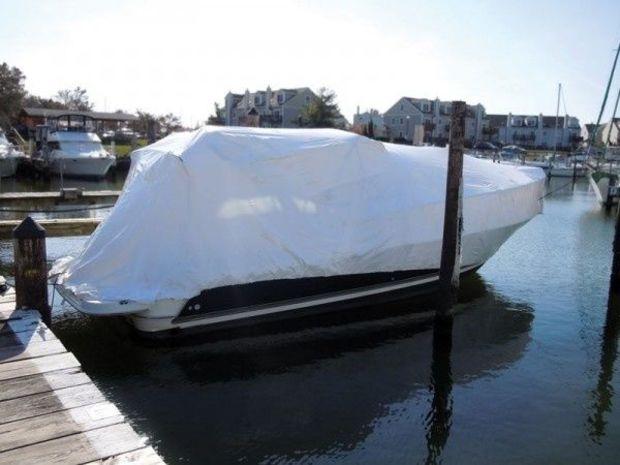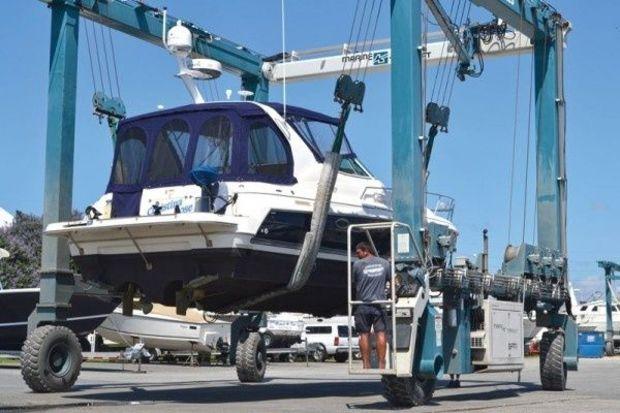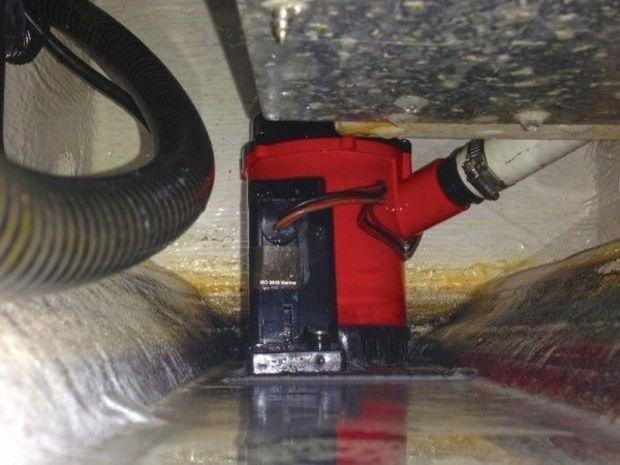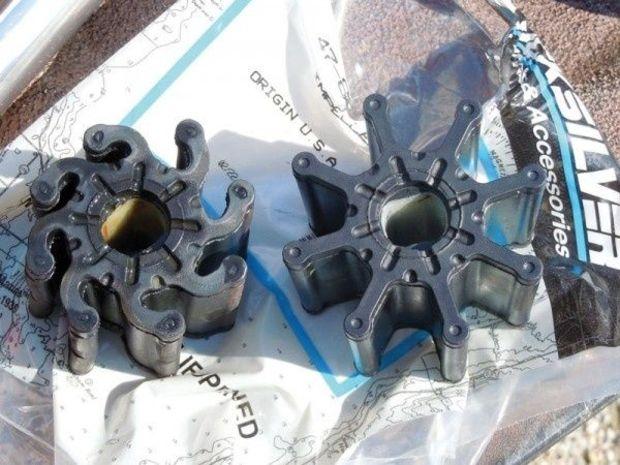While Andy Williams might think he knows The Most Wonderful Time of the Year, he apparently never boated on the Chesapeake, because there would be an even better song sung about spring commissioning. The time spent getting my boat ready to launch is inversely proportional to efforts closing up last season; recommissioning is easy, but still potentially dangerous if certain tasks are overlooked.
While my boat is likely different than yours, the process to get any vessel ready for launch is basically the same from jon boat to ocean-going freighter; the focus is always bottom-to-top, in that order. I simply first pay attention to everything I can’t access while the boat is in the water; everything else could be taken care of later.

Starting with my hull’s undersides, I break down the tasks into three categories: appearance, operation, and safety. Determining how clean my hull is and how much bottom paint remains from last season’s haul-out and power washing is relatively straightforward. While aesthetics of the hull are of minimal concern to me, they do relate directly to how well-protected my boat is from the future season’s crustaceans and corrosion, and equally important (to me) is smoothness; a smooth hull is an economical hull, and I need every improvement I can get with this pig. If my bottom is rough, I scour and sand it. If my hull is missing bottom paint, I paint it. If there are barnacles anywhere, I scrape them off. Okay, lately I pay someone to do that miserable stuff, but it still has to be done.
Operational condition of all my running gear is usually good in the spring, as I typically address any issues during the season. If it’s been a few seasons, I’ll send my props out for tuning during winter layup; spring conditioning is the time to reinstall those props as I fully examine my cutlasses, shafts, rudders, props, and plates for any signs of galvanic corrosion or play developed during last season. Now is the time I replace any pitted sacrificial zincs too.

More important than appearance or operation, safety is paramount when dealing with my undersides. Every opening in the hull is an opportunity for a boat to go sub-marine, so I inspect all my thru-hulls thoroughly and don’t mess around waiting to replace any showing signs of less-than-perfect condition. I routinely go hundreds of miles away from my marina and sleep overnight on my boat with my family. I wouldn’t sleep very well if I knew there was a problem I didn’t take care of before launch.

With the undersides complete, the last bit of safety I focus on is topside where any hose connects to a thru-hull. I ensure hoses to every thru-hull below the waterline have two tight clamps, snugging each. I snug all the other hose clamps around the engine bay and bilges too. While in the bilge, I look around for plastic bags, rags, or any other foreign stuff that might be waiting to clog the bilge pumps. I operate each seacock a couple of times to ensure free movement, in case there’s ever an emergency at sea.
Since my boat has freshwater systems (head, galley sinks, and showers), the next thing I do is re-check or connect all hoses in the system that I may have opened when pumping pink antifreeze for layup. Once connected, I fill my water tank and run the boat’s pump until it shuts itself off, letting me verify that the freshwater system holds pressure for some period of time and telling me I have no leaks. If the pump runs and runs, I go looking for water that shouldn’t be there.

Once the freshwater pump shuts off and holds pressure, I’ll pump at least two tanks worth of water (70 gallons) through all the systems to flush any of the winter’s antifreeze from the lines. I can’t tell you how many times I’ve forgotten to flush the hot water heater before firing up my engines, and trust me; hot antifreeze stinks for a very long time!
That said, one thing I’ve found over the years to be pretty effective is this chlorine dioxide potable water treatment from Aquamira. It’s a two-part chemical that does a really good job getting rid of foul water odors or tastes in my lines from winter layup, doing a nearly immediate fix. I fill one tank worth with this mixture, pump it through all of the system, then treat one more tank of water I intend to leave in the boat until used.

Mold seems as common to stored boats as spiders, so it’s next on my list of things to get rid of, especially belowdecks before closing the cabin door. No matter how well I clean before layup, enclosed spaces allow mold to grow. I’ve found Spray Nine Mold & Mildew and Tilex Mold & Mildew to be extremely effective on anything I can wipe with a rag, plus I like the mold and mildew foggers I can set off and then close the cabin door behind me as I leave. I generally try not to vacuum anything until the mold is killed, nor do I bring any linens, cushions, or canvas onboard until everything is clean. Usually, I leave cleaning the topsides until I’m at sea, while relaxing away from land and people with my favorite beverage in hand.
The biggest commissioning advice I can give is not rushing that first launch of your boat away from the trailer or lift while everyone is watching; take your time to investigate everything before pulling your boat away. Fight the urge to get out of people’s way for your open spot, because if anything is going to happen, it’ll be within seconds of leaving safety. Once, I pulled my trailer out from under my boat, parked it, only to see water pouring from the bilge-pump on my return; if you think you look foolish keeping your trailer in people’s way, just wait until a forgotten drain plug forces you to put your trailer back in the water.

Run your engines a while before pulling away, sticking your head in the engine room one last time to verify everything is dry; while an open drain plug is embarrassing, an open engine coolant line fills a boat quicker than a bilge pump can evacuate, causing a boat to catch fire moments before it sinks. Trust me, those flames were completely visible to the people I rushed away from…
 Starting with my hull’s undersides, I break down the tasks into three categories: appearance, operation, and safety. Determining how clean my hull is and how much bottom paint remains from last season’s haul-out and power washing is relatively straightforward. While aesthetics of the hull are of minimal concern to me, they do relate directly to how well-protected my boat is from the future season’s crustaceans and corrosion, and equally important (to me) is smoothness; a smooth hull is an economical hull, and I need every improvement I can get with this pig. If my bottom is rough, I scour and sand it. If my hull is missing bottom paint, I paint it. If there are barnacles anywhere, I scrape them off. Okay, lately I pay someone to do that miserable stuff, but it still has to be done.
Operational condition of all my running gear is usually good in the spring, as I typically address any issues during the season. If it’s been a few seasons, I’ll send my props out for tuning during winter layup; spring conditioning is the time to reinstall those props as I fully examine my cutlasses, shafts, rudders, props, and plates for any signs of galvanic corrosion or play developed during last season. Now is the time I replace any pitted sacrificial zincs too.
Starting with my hull’s undersides, I break down the tasks into three categories: appearance, operation, and safety. Determining how clean my hull is and how much bottom paint remains from last season’s haul-out and power washing is relatively straightforward. While aesthetics of the hull are of minimal concern to me, they do relate directly to how well-protected my boat is from the future season’s crustaceans and corrosion, and equally important (to me) is smoothness; a smooth hull is an economical hull, and I need every improvement I can get with this pig. If my bottom is rough, I scour and sand it. If my hull is missing bottom paint, I paint it. If there are barnacles anywhere, I scrape them off. Okay, lately I pay someone to do that miserable stuff, but it still has to be done.
Operational condition of all my running gear is usually good in the spring, as I typically address any issues during the season. If it’s been a few seasons, I’ll send my props out for tuning during winter layup; spring conditioning is the time to reinstall those props as I fully examine my cutlasses, shafts, rudders, props, and plates for any signs of galvanic corrosion or play developed during last season. Now is the time I replace any pitted sacrificial zincs too.
 More important than appearance or operation, safety is paramount when dealing with my undersides. Every opening in the hull is an opportunity for a boat to go sub-marine, so I inspect all my thru-hulls thoroughly and don’t mess around waiting to replace any showing signs of less-than-perfect condition. I routinely go hundreds of miles away from my marina and sleep overnight on my boat with my family. I wouldn’t sleep very well if I knew there was a problem I didn’t take care of before launch.
More important than appearance or operation, safety is paramount when dealing with my undersides. Every opening in the hull is an opportunity for a boat to go sub-marine, so I inspect all my thru-hulls thoroughly and don’t mess around waiting to replace any showing signs of less-than-perfect condition. I routinely go hundreds of miles away from my marina and sleep overnight on my boat with my family. I wouldn’t sleep very well if I knew there was a problem I didn’t take care of before launch.
 With the undersides complete, the last bit of safety I focus on is topside where any hose connects to a thru-hull. I ensure hoses to every thru-hull below the waterline have two tight clamps, snugging each. I snug all the other hose clamps around the engine bay and bilges too. While in the bilge, I look around for plastic bags, rags, or any other foreign stuff that might be waiting to clog the bilge pumps. I operate each seacock a couple of times to ensure free movement, in case there’s ever an emergency at sea.
Since my boat has freshwater systems (head, galley sinks, and showers), the next thing I do is re-check or connect all hoses in the system that I may have opened when pumping pink antifreeze for layup. Once connected, I fill my water tank and run the boat’s pump until it shuts itself off, letting me verify that the freshwater system holds pressure for some period of time and telling me I have no leaks. If the pump runs and runs, I go looking for water that shouldn’t be there.
With the undersides complete, the last bit of safety I focus on is topside where any hose connects to a thru-hull. I ensure hoses to every thru-hull below the waterline have two tight clamps, snugging each. I snug all the other hose clamps around the engine bay and bilges too. While in the bilge, I look around for plastic bags, rags, or any other foreign stuff that might be waiting to clog the bilge pumps. I operate each seacock a couple of times to ensure free movement, in case there’s ever an emergency at sea.
Since my boat has freshwater systems (head, galley sinks, and showers), the next thing I do is re-check or connect all hoses in the system that I may have opened when pumping pink antifreeze for layup. Once connected, I fill my water tank and run the boat’s pump until it shuts itself off, letting me verify that the freshwater system holds pressure for some period of time and telling me I have no leaks. If the pump runs and runs, I go looking for water that shouldn’t be there.
 Once the freshwater pump shuts off and holds pressure, I’ll pump at least two tanks worth of water (70 gallons) through all the systems to flush any of the winter’s antifreeze from the lines. I can’t tell you how many times I’ve forgotten to flush the hot water heater before firing up my engines, and trust me; hot antifreeze stinks for a very long time!
That said, one thing I’ve found over the years to be pretty effective is this chlorine dioxide potable water treatment from Aquamira. It’s a two-part chemical that does a really good job getting rid of foul water odors or tastes in my lines from winter layup, doing a nearly immediate fix. I fill one tank worth with this mixture, pump it through all of the system, then treat one more tank of water I intend to leave in the boat until used.
Once the freshwater pump shuts off and holds pressure, I’ll pump at least two tanks worth of water (70 gallons) through all the systems to flush any of the winter’s antifreeze from the lines. I can’t tell you how many times I’ve forgotten to flush the hot water heater before firing up my engines, and trust me; hot antifreeze stinks for a very long time!
That said, one thing I’ve found over the years to be pretty effective is this chlorine dioxide potable water treatment from Aquamira. It’s a two-part chemical that does a really good job getting rid of foul water odors or tastes in my lines from winter layup, doing a nearly immediate fix. I fill one tank worth with this mixture, pump it through all of the system, then treat one more tank of water I intend to leave in the boat until used.
 Mold seems as common to stored boats as spiders, so it’s next on my list of things to get rid of, especially belowdecks before closing the cabin door. No matter how well I clean before layup, enclosed spaces allow mold to grow. I’ve found Spray Nine Mold & Mildew and Tilex Mold & Mildew to be extremely effective on anything I can wipe with a rag, plus I like the mold and mildew foggers I can set off and then close the cabin door behind me as I leave. I generally try not to vacuum anything until the mold is killed, nor do I bring any linens, cushions, or canvas onboard until everything is clean. Usually, I leave cleaning the topsides until I’m at sea, while relaxing away from land and people with my favorite beverage in hand.
The biggest commissioning advice I can give is not rushing that first launch of your boat away from the trailer or lift while everyone is watching; take your time to investigate everything before pulling your boat away. Fight the urge to get out of people’s way for your open spot, because if anything is going to happen, it’ll be within seconds of leaving safety. Once, I pulled my trailer out from under my boat, parked it, only to see water pouring from the bilge-pump on my return; if you think you look foolish keeping your trailer in people’s way, just wait until a forgotten drain plug forces you to put your trailer back in the water.
Mold seems as common to stored boats as spiders, so it’s next on my list of things to get rid of, especially belowdecks before closing the cabin door. No matter how well I clean before layup, enclosed spaces allow mold to grow. I’ve found Spray Nine Mold & Mildew and Tilex Mold & Mildew to be extremely effective on anything I can wipe with a rag, plus I like the mold and mildew foggers I can set off and then close the cabin door behind me as I leave. I generally try not to vacuum anything until the mold is killed, nor do I bring any linens, cushions, or canvas onboard until everything is clean. Usually, I leave cleaning the topsides until I’m at sea, while relaxing away from land and people with my favorite beverage in hand.
The biggest commissioning advice I can give is not rushing that first launch of your boat away from the trailer or lift while everyone is watching; take your time to investigate everything before pulling your boat away. Fight the urge to get out of people’s way for your open spot, because if anything is going to happen, it’ll be within seconds of leaving safety. Once, I pulled my trailer out from under my boat, parked it, only to see water pouring from the bilge-pump on my return; if you think you look foolish keeping your trailer in people’s way, just wait until a forgotten drain plug forces you to put your trailer back in the water.
 Run your engines a while before pulling away, sticking your head in the engine room one last time to verify everything is dry; while an open drain plug is embarrassing, an open engine coolant line fills a boat quicker than a bilge pump can evacuate, causing a boat to catch fire moments before it sinks. Trust me, those flames were completely visible to the people I rushed away from…
Run your engines a while before pulling away, sticking your head in the engine room one last time to verify everything is dry; while an open drain plug is embarrassing, an open engine coolant line fills a boat quicker than a bilge pump can evacuate, causing a boat to catch fire moments before it sinks. Trust me, those flames were completely visible to the people I rushed away from…